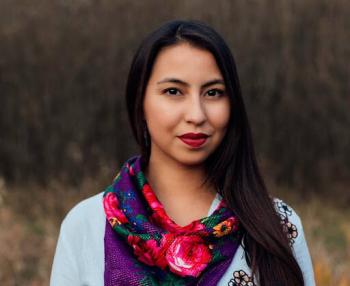Image Caption
Summary
Local Journalism Initiative Reporter
Windspeaker.com
Michelle Myers’ clean energy journey began back in 2016 when she attended a summit while she was a student in university.
And now her Xeni Gwet’in First Nation in British Columbia will soon be reaping the benefits of her participation.
While attending a clean energy summit five years ago in Waterloo, Ont., Myers, who was studying at the University of Alberta, was told about a new program offered by the Indigenous Clean Energy (ICE) Social Enterprise.
Myers was convinced to join the first cohort for ICE’s 20/20 Catalysts, a national clean energy capacity building program for Indigenous individuals across Canada.
Myers and several other current and former participants of the program were featured in a presentation on Wednesday, Jan. 20 during the Indigenous Clean Energy E-Gathering.
Program participants discussed the various ventures they are now involved with in their communities.
“I was in my third year of university for a Bachelor of Arts in Native Studies with a minor in Environmental Conservation,” Myers recalled of the time she discovered the Catalysts Program.
While continuing her education, Myers simultaneously enrolled in the three-month program, which connects participants to both Indigenous and non-Indigenous clean energy project mentors.
Those in the program learn about clean energy project developments, including information on energy efficiency, solar, wind, hydro, biomass, geothermal as well as on-grid and off-grid ventures.
Myers was able to juggle her university studies with her Catalysts learning.
“From there I was just immensely inspired by everybody that attended and inspired by the initiative and the directive,” Myers said.
Upon graduation, Myers returned to her community and landed various contract jobs. Then, an opportunity to work on her First Nation’s clean energy plan arose.
That led to her current responsibilities where she not only oversees clean energy projects in her community but has become the lands and resources manager for Xeni Gwet’in, located in central interior B.C.
Her community is an off-grid remote one, which is not connected to the BC Hydro grid and is currently diesel powered.
“My home right now is powered by an individual gas generator and I’m currently running off a battery that I charge with my generator at night,” Myers said.
But plenty of positive changes are in store for her community.
“We’re installing an underground line, extending from our microgrid in our central community to 28 homes,” Myers said. “The underground line idea comes from many years of community engagement around clean energy projects and clean energy development of our community not wanting to see power lines or power poles going right through our valley because we hold the esthetic value of our community and our territory very high.”
Myers said Xeni Gwet’in has become a popular tourist destination, as well as a sought-after location for making movies.
“We have a lot of opportunities for tourism,” she said. “We have a lot of people that come into our communities and want to utilize our territory for films.”
And this helps explain why community members are not keen for many visible changes.
“We also have a lot of ceremonial gatherings and traditional spots all the way from the central, middle of the community out to here and beyond that an overhead power line would kind of get in the way of and disturb if we went that route,” she said.
George Colgate, the underground distribution line project manager for Xeni Gwet’in, explained there will soon be substantial savings for community members who currently operate their own generators for power.
“Running a small generator probably works out to about $2 a kilowatt hour,” he said. “Once this is in, people are going to be paying BC Hydro rates out. That’s the idea. For Tier 2, I think that somewhere around 8-10 cents a kilowatt hour.”
Another participant featured in Wednesday’s presentation was Alex Cook, the owner of a start-up business based in Iqaluit.
His company has a vision of developing affordable, efficient and resilient housing for rapid deployment to remote Arctic communities.
These houses will be partially built with shipping containers.
“For as long as I can remember, Nunavut has struggled with a housing crisis,” Cook said. “The housing crisis has gotten so bad that right now across the territory there are people living outside in nothing more than tents and shacks.”
With the contacts he made through the Catalysts Program, Cook believes he’ll be able to design Nunavut’s first accessible net zero home.
The prototype will be built in his community of Baker Lake this fall.
“Our people are strong,” Cook said. “We figured how to live here before. We’ll do it again.”
Another program participant is Nathan Kaye, a finance student at the Southern Alberta Institute of Technology in Calgary.
Kaye is also the co-chair of SevenGen, a virtual youth summit that will be held next month.
“What we hope to accomplish there is to get youth to initiate renewable energy products in their communities by providing support, services and funding for those projects,” Kaye said.
That summit has expanded and will feature an Indigenous youth mentorship program.
Kaye is also involved in a food security initiative with Tsuut’ina Nation.
“We built a community garden back in April and May,” he said. “And right now we’re working on building a geothermal greenhouse.”
The Indigenous Clean Energy E-Gathering began on Monday and continues until Friday.
Local Journalism Initiative Reporters are supported by a financial contribution made by the Government of Canada.

